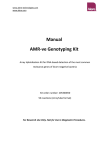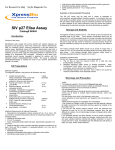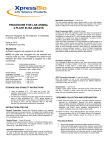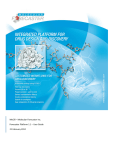Download For Research Use Only Not for Diagnostic Use
Transcript
For Research Use Only Not for Diagnostic Use TECHNICAL ASSISTANCE Please refer any technical questions to [email protected]. SAFETY INFORMATION HIV-1 Integrase Assay Kit Mutant N155H Version 1.0 Catalog Number EZ-1800 STORAGE CONDITIONS INTRODUCTION HIV DNA is integrated into host DNA by a viral encoded integrase and this enzyme activity is a likely target site in the HIV life cycle to block viral infection. Treatment of HIV infected patients, with certain antiviral drugs, can result in specific mutations within the integrase gene that confer drug resistance to the virus. We have developed an integrase assay that allows for the measurement of catalytic activity modifications caused by specific mutations within the integrase protein in order to enhance mechanistic drug discovery research. In this kit, the amino acid change at position 155 from asparagine to histidine. The XpressBio HIV-1 Integrase Assay Kit is a non-radioactive assay used to quantitatively measure integrase activity, the effects of interacting proteins, anti-viral compounds, and other test articles on HIV-1 integrase activity. Streptavidin-coated 96-well plates are coated with a double-stranded HIV-1 LTR U5 donor substrate (DS) DNA containing an end-labeled biotin. Full-length recombinant HIV-1 mutant N155H integrase protein is loaded onto the DS DNA substrate. Integrase test articles are added to the enzyme reaction and then a different double-stranded target substrate (TS) DNA containing a 3’-end modification is added to the reaction mixture. The HIV-1 integrase cleaves the terminal two bases from the exposed 3’-end of the HIV-1 LTR DS DNA and then catalyzes a strand-transfer recombination reaction to integrate the DS DNA into the TS DNA. The products of the reaction are detected colorimetrically using an HRP-labeled antibody directed against the TS 3’-end modification. Sodium azide is included in the kit as a positive control compound that inhibits HIV-1 integrase catalytic activity. KIT CONTENTS Product Reaction Buffer Blocking Buffer DS Oligo DNA 100X Solution Mutant N155H Integrase (2 μM) Sodium Azide (20%) TS Oligo DNA 100X Solution HRP Antibody Solution Dilution Plate Streptavidin-coated 96-well Plate Wash Buffer Concentrate 20X TMB Peroxidase Substrate Stop Solution Instruction Manual Catalogue EZ-1701 EZ-1702 EZ-1703 EZ-1710 EZ-1705 EZ-1706 EZ-1707 EZ-1708 EZ-1709 82710 XB-1006 XB-1007 NA Sodium azide may react with lead and copper plumbing to form explosive azide compounds. When disposing of reagents, flush with copious quantities of water. The MSDS for this kit is available online at www.expressbiotech.com. Per Kit 220 mL 30 mL 120 μL 155 μL 2 X 1 mL 60 μL 12 mL 1 plate 1 plate 60 mL 12 mL 12 mL 1 The streptavidin-coated plate, reaction buffer, block buffer, sodium azide, HRP antibody, TMB, wash solution, and the stop solution should be placed at 2-8ºC. The DS and TS DNAs, and the integrase enzyme should be stored at -20ºC or cooler. The kit is stable for one year under these conditions. Microwell strips of the streptavidin-coated plate that are not used after opening the foil pouch should be returned to the pouch along with the sachet of desiccant, closed with a pouch sealer or adhesive tape, and stored at 2-8ºC until the expiration date on the label. Reaction buffer (2 ml per reaction well) should be activated by the addition of mercaptomethanol (BME, 0.4 l/1 ml) just prior to assay. BME-activated reaction buffer is stable for one week at 2-8ºC. Reaction buffer may settle during storage, so the bottle should be warmed to 37º C and mixed before use. REAGENTS AND EQUIPMENT SUPPLIED BY THE USER Pipettors and sterile tips Disposable gloves 14.5 M β-mercaptoethanol (BME) Paper towels Sterile distilled (deionized) water A 37ºC incubator A 37ºC water bath A 96-well plate reader capable of reading at 450 nm NOTES BEFORE STARTING General Comments Carefully review the protocol before beginning, since small deviations may lead to discrepancies in the final results. All incubation steps should be performed within +/- 2 min of the indicated times. Each lot of ExpressBio HIV Integrase Assay Kit has been extensively tested and the conditions under which the kit is shipped and stored have been shown empirically to not impact assay performance. As with all other 96-well applications, there may be a slight difference in assay performance when the plate outer wells, and especially the plate corners are used. Consequently, the inner wells of the plate should be used preferentially in your experimental design whenever critical results are required. the other components of the kit except the mutant integrase enzyme by placing them at room temperature. Wash Buffer Concentrate 2. Coat with DS DNA Wash buffer is provided as a 20X concentrate. Mix 50 mL of 20X wash buffer concentrate with 950 mL sterile distilled water to make a 1X wash buffer solution before use. Remove any strip wells from the streptavidin-coated 96-well plate that will not be used and reseal them in the foil pouch containing desiccant. Dilute the required amount of DS DNA 100X solution 100-fold in reaction buffer (10 μL DS DNA 100X solution and 990 μL reaction buffer). Add 100 μL of 1X DS DNA solution per well and incubate for 30 min in a 37ºC incubator. Return the reaction buffer to the 37ºC water bath. Reaction Buffer Reaction buffer (1x) contains both manganese and magnesium, and requires the addition of 0.4 μl of BME/mL of reaction buffer before use. Prepare 2 ml of reaction buffer for each well. Reaction buffer is stable for one week stored at 28ºC after addition of BME. Add BME to the appropriate amount of buffer, do not activate the entire 220 ml bottle unless all will be used. The reaction buffer may settle in the bottle and it should be mixed/swirled gently before use. 3. Blocking the plate Aspirate the liquid from the plate wells and wash five times with 300 μL 1x wash buffer. Add 200 μL of blocking buffer per well and incubate for 30 min in a 37ºC incubator. If required, the plate may now be placed at 2-8ºC overnight and later placed in a 37ºC incubator for 20 min before continuing with the protocol, however the kit performs slightly better if the entire protocol is performed in one day. DS and TS DNAs The DS and TS DNAs are provided as 100X solutions that should be diluted 100-fold into reaction buffer before use. The diluted 1X DS and TS DNA solutions are not stable and the amount required for an experiment should be prepared just before use. The 100X stocks of these DNAs are virtually unaffected by multiple freeze-thaw cycles. The TS DNA is light-sensitive and may leech onto polypropylene tubes. Integrase Reaction 4. Load the integrase onto DS DNA Thaw the HIV-1 integrase on wet ice or at 2-8ºC (~5 min) before it is needed and centrifuge the tube briefly (ex. 10,000 RPM X 5 sec) before use. Dilute the enzyme 1:65 into reaction buffer (2 μL HIV-1 integrase and 128 μL reaction buffer). Aspirate the liquid from the plate wells and wash three times with 200 μl reaction buffer. Add 100 μL of reaction buffer (negative control) or integrase enzyme solution (positive control) per well and incubate for 30 min in a 37ºC incubator. Include reaction buffer only replicates (without integrase) as a no enzyme negative control. Return the reaction buffer to the 37ºC water bath. HIV-1 Mutant N155H Integrase Protein Stability The HIV-1 mutant N155H integrase protein should be stored at -20º C or colder and is stable to freeze-thaw cycles with 10-12 possible. Before each use the enzyme solution should be thawed on ice for five minutes and then re-frozen. Plate Washing Steps Washing can be done manually with a wash bottle or with an automatic plate washer. The liquid should be completely removed from the plate wells after each washing step by patting the plate down onto a stack of paper towels. 5. Add Inhibitors or Test Articles Prepare test articles by diluting to 2X final desired test concentration in reaction buffer. For example, prepare a 20 μM or 20 μg/mL solution and serially dilute in reaction buffer when a 10 μM or 10 μg/mL high-test concentration is desired for the assay. Azide solution diluted to 0.30% (2X concentration or 0.15% final 1X concentration) inhibits approximately 50% of the integrase activity. Include 50 L reaction buffer negative and positive control replicates (no test article) in each experiment. Test articles may contain up to 10% dimethyl sulfoxide (DMSO), since the integrase reaction is only marginally affected by the presence of up to 5% DMSO in the final reaction. Replicates We recommend all samples and controls are tested using 2-3 replicate wells in each experiment. The use of additional replicates for the blank (no integrase) and the integrase-alone controls (no test article) may reduce variability in the assay. HIV INTEGRASE ASSAY KIT PROTOCOL DS Coating and Blocking of SA Plate Aspirate the liquid from the plate wells and wash them three times with 200 μL reaction buffer. Add 50 μL per well of each test article in reaction buffer (reaction buffer alone for positive and negative controls) and incubate for 5 min at room temperature. 1. Prewarm reagents Place the reaction buffer and the blocking solution in a 37ºC water bath for 10 min before starting the assay. Prewarm all 2 absorbance of the test articles divided by the mean integrase control activity multiplied by the associated CV provides the percent adjusted standard deviation. The CV = %SD for the 100% mutant integrase alone control. 6. Add TS DNA Dilute the required amount of TS DNA 100X solution 100-fold in reaction buffer (10 μL TS DNA 100X solution and 990 μL reaction buffer per mL). Add 50 μL of the 1X TS DNA solution per well directly to the 50 μL buffer/test articles already present in the wells. Mix the reactions by tapping the plate gently against a stationary hand 3-5 times. Incubate for 30 min at 37ºC. Typical assay results for buffer/no mutant integrase, mutant N155H integrase alone/no azide, and mutant N155H integrase plus azide (each point run in triplicate) are tabulated below for the inhibition of the mutant N155H HIV-1 integrase when treated with azide: Detection of Reaction Products Sample ID 7. Add HRP Antibody Aspirate the liquid from the plate wells and wash five times with 300 μL wash solution. Add 100 μL HRP antibody solution per well and incubate for 30 min at 37ºC. Buffer Integrase 2.0% Azide 1.5% Azide 1.0% Azide 0.6% Azide 0.4% Azide 0.2% Azide 0.1% Azide 0.05%Azide 8. Add TMB Peroxidase Substrate Aspirate the liquid from the plate wells and wash five times with 300 μL wash solution. Add 100 μL TMB peroxidase substrate solution per well and incubate for 10 minutes at room temperature. 9. Add TMB Stop Solution Mean OD (Corrected) 0.000 3.030 0.013 0.118 0.256 0.341 0.606 1.240 2.135 2.788 Std. Deviation (Corrected) 0.007 0.178 0.002 0.012 0.041 0.015 0.088 0.085 0.222 0.396 % CV --5.9% 15.4% 10.2% 16.0% 4.4% 14.5% 6.9% 10.4% 14.2% % Control Activity --100% 0.04% 3.9% 8.4% 11.3% 20% 41% 70% 92% A graph illustrating the dosage-dependent inhibitory effect of azide on the catalytic activity of the HIV-1 integrase is shown below, which is similar for both wild-type and mutant N155H integrase. Add 100 μL TMB stop solution directly to the wells containing the TMB substrate. Burst any large bubbles by using a pipette tip. Read the absorbance of the wells for a minimum of 0.1 sec using a plate reader set at 450 nm. Plates should be read within 10 min of adding TMB stop solution. If the OD 450 nM absorbance is above the range of the plate reader the reactions can be dilute in order to realize a more accurate reading end point. Add 100 l of the assay reaction wells to 100 l of dH2O into the dilution plate/strip or well (EZ1709 provided, do not use the SA-coated plate/strips) and read the absorbance at 450 nM. The absorbance values from the diluted samples should be multiplied by 2. DATA ANALYSIS AND ASSAY PERFORMANCE Experimental data are analyzed as described below; typically, duplicate or triplicate determinations are obtained for each control/sample/drug/test-article in each experiment. Determine the mean blank absorbance (reaction buffer negative control) in the assay from the no integrase/no test article control (usually less than 0.25 OD units) and subtract this background absorbance from the other readings. The inhibitory concentration of azide that reduces both integrases by 50% and 90% are similar for both the wild-type and the mutant N155H integrase. The mutant N155H integrase demonstrated an IC50 value of 0.18 % and the IC90 value was approximately 0.64%. Azide-mediated inhibition of both integrase enzymes is independent of the change of amino acid 144 from asparagines to histidine. Calculate the mean +/- standard deviation (SD) and CV (SD/mean X 100%) for the background corrected absorbance of integrase alone (positive control) and test articles replicate wells. Convert the data to percent control activity by dividing the mean absorbance of test articles by that of the integrase alone control and multiplying by 100%. The mean The data from a typical experimental determination with the mutant N155H integrase and the inhibitor Elvitegravir (EVG) are tabulated below: 3 Sample ID Reaction Buffer Integrase Alone 3.0 M EVG 1.0 M EVG 0.5 M EVG 0.25 M EVG 0.10 M EVG 0.05 M EVG 0.01 M EVG 0.005 M EVG 0.000 Std. Deviation (Corrected) 0.007 --- % Control Activity --- 4.92 0.271 5.5% 100% 0.169 0.011 6.5% 3.5% 0.300 0.043 14.3% 6.1% 0.323 0.026 8.0% 6.8% 0.478 0.039 8.2% 9.7% 0.950 0.123 12.9% 19.3% 1.16 0.099 8.5% 23.6% 2.69 0.345 12.8% 55% 4.82 0.258 5.4% 98% Mean OD (Corrected) % CV same molar amounts of integrase. The wild-type enzyme demonstrated a higher sensitivity towards the inhibitory effects of Elvitegravir and Raltegravir. Raltegravir inhibits wild-type integrase at lower concentrations compared to the mutant N155H enzyme as shown below. A graph illustrating the dosage-dependent inhibitory effect of Raltegravir and Elvitegravir on the catalytic activity of mutant N155H HIV-1 Integrase is shown below. TROUBLESHOOTING GUIDE The inhibitory concentration of Raltegravir and Elvitegravir that reduces mutant N155H integrase activity by 50% (IC50) and 90% (IC90) may be interpolated from the data and the curve. In this experiment, Elvitegravir showed an IC50 of 16.4 nM and an IC90 of 250 nM, while Raltegravir showed an IC50 of 67 nM and an IC90 of 1.5 M. The mutant N155H integrase is significantly more sensitive/susceptible to the inhibitory action of elvitegravir compared to raltegravir. The graph below demonstrates dramatic differences in the inhibition profiles of elvitegravir on wild-type and mutant N155H integrase when the assay was performed using the 4 Problem Integrase alone signal >3.0 Suggestion . Dilute stopped reaction 1:1 in dH2O into a blank strip or well (do not use SA-coated plate). Dilute integrase enzyme at 1:70 in buffer in reaction step 4 above. Integrase alone signal <0.5 Spin down integrase before use. Dilute integrase enzyme 1:60 in step 4 above. Increase the TMB incubation time to 20-30 min. Wells are stained blue Add stop reagent before reading plates or read plate at 405 nM instead of 450 nM. Background is high >0.35 Replace reaction buffer. Use reaction buffer within one week of adding BME. Swirl the buffer bottle before use. Review plate washing steps above. EXPERIENCED USERS PROTOCOL 1. Prewarm reagents, 100 μL DS oligo, 30 min at 37ºC. 2. 5 X 300 μL wash buffer, 200 μL block, 30 min at 37ºC. 3. 3 X 200 μL reaction buffer wash, 100 μL of 1:65 dilution of mutant integrase in reaction buffer, 30 min at 37ºC. 4. 3 X 200 μL reaction buffer wash, 50 μl reaction buffer or test article in reaction buffer, 5 min at room temperature. 5. 50 μL of TS oligo, 30 min at 37ºC. 6. 5 X 300 μL wash buffer, 100 μL HRP antibody, 30 min at 37ºC. 7. 5 X 300 μL wash buffer, 100 μL/well of TMB substrate, 10 min at room temperature. 8. 100 μL TMB stop solution, read OD at 450 nM. CONTRACT RESEARCH Need a hand with your research? Would you like independent confirmation of your results? Why not let us perform the HIV-1 integrase assay for you? Contact us for more information. CONTACT INFORMATION Express Biotech International 503 Gateway Drive West Thurmont, MD 21788 USA Toll free: 888-562-8914 www.XpressBio.com [email protected] Tel: 301-228-2444 Fax: 301-560-6570 5














